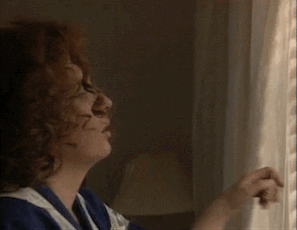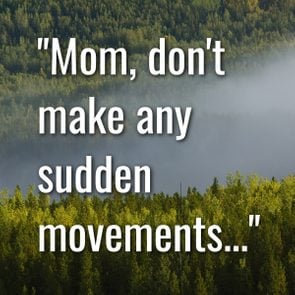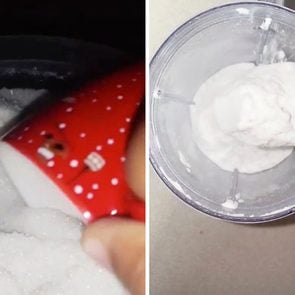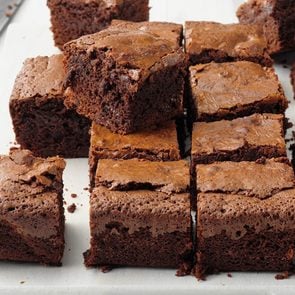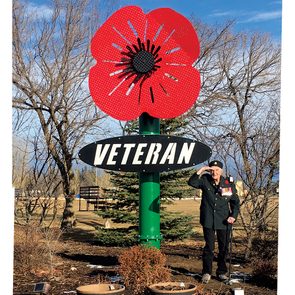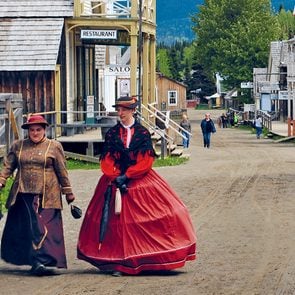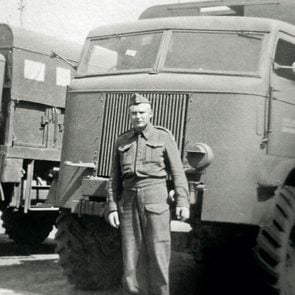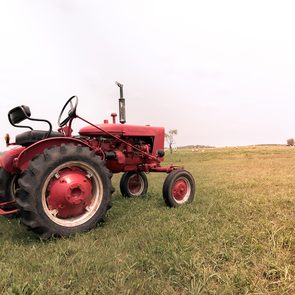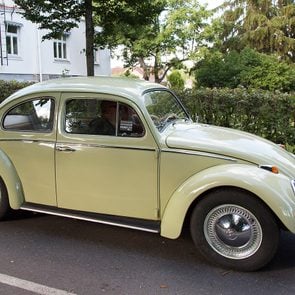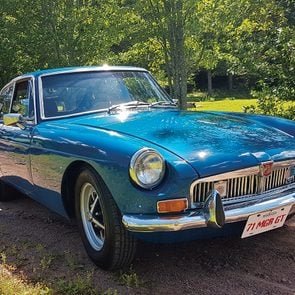If you’re not drinking milk every day, the idea of finishing off four litres of bagged milk can be daunting. After all, you don’t have much time to waste: milk lasts only four to seven days past its use-by date once opened. (Here are more expiration dates you should never ignore.)
Luckily, we know a simple trick to avoid having to pour your milk (and money!) down the drain. Follow along to learn how to freeze milk.
Yes, milk can last for several months in the freezer, but for the best quality, we advise consuming it within the first month. After that point, milk will begin to separate and turn grainy. Because freezing changes the texture of milk, most people prefer to cook with thawed milk instead of drink it.
Tips for freezing milk
Freezing milk is simple, but you need to avoid a few pitfalls:
- Always leave 1 to 1-1/2 inches of headspace in the container before freezing. Like other liquids, milk expands when it’s frozen. Having too much in the container can cause it to crack.
- Store milk in an airtight container. Milk is highly susceptible to picking up odours from other foods in the freezer. This can change the milk’s flavour once thawed.
- Skim milk is more freezer-friendly than full-fat milk. Milk with a higher fat content separates more readily when thawed.
The best way to freeze milk
Our favourite way to freeze milk was brought to us by reader Ruth M. of Tunnel Hill, Georgia:
“To save it, I pour it into clean ice cube trays and freeze them. When they’re frozen, I put the cubes in heavy-duty resealable plastic bags or containers. When a recipe calls for milk, I take out just the number of cubes needed.”
Using Ruth’s tip can help you save freezer space, plus it lets you thaw exactly the amount of milk you need.
For reference, two cubes in the average ice cube tray will equal about 1/4 cup milk. If you’re looking to use larger portions of milk at a time, try a specialty 1-cup ice cube tray set that’s great for freezing soup and stock, too.
How to thaw frozen milk
Simply leave frozen milk in the fridge to thaw overnight. If the milk has separated a bit, give it a vigorous shake before using.
Now that you know you can freeze milk, find out 12 clever cooking hacks that’ll save you time (and money) in the kitchen.
My body is nearly perfect. Well, not only mine–yours, too. Consider, for one thing, how your fingernail is tough enough to scrape off the blackened residue from the bottom of an enamel pot, yet soft enough that it doesn’t leave a scratch. Despite many decades of work by the manufacturers of scouring pads, brushes and sponges, no other material has been found that so perfectly performs this simple task.
The human body has been getting a bad rap lately. Covid-19 owes much of its power to the body’s occasional tendency to do battle with itself. The coronavirus can set off what’s called a cytokine storm, a sometimes-fatal overreaction of the immune system. In the effort to repel the invading army, the body blows up its own munitions dump.
So in times like these, it might be worth remembering all the ways that, most of the time, the body does a tip-top job.
For example, your nose is full of tiny hairs that catch dust in the air before it enters the lungs. Your throat rarely malfunctions, even though it’s required to do unlikely double-service as a highway for both air and food.
Or consider this piece of genius engineering: The human forehead produces a sheen of moisture on a hot day in a way that helps the body shed heat. The hotter you get, the more sweat you produce. Clever, right?
As Bill Bryson notes in his book The Body: A Guide for Occupants, it is estimated that between one and five of your cells turn cancerous every day. And nearly every time, your immune system locates and kills them. As Bryson puts it: “Our bodies are a universe of 37.2 trillion cells operating in more or less perfect concert more or less all the time.”
Some things, I admit, are not ideal. Take the fact that an adult male of normal proportions will, when run at by a toddler, find that his genitals are at the perfect height for a high-speed collision. If done with sufficient vigour, the impact may even prevent the creation of further children. As sibling rivalries go, that’s not a bad effort.
The arrival of pimples during adolescence also remains a mystery. First of all, do they have to appear on the face, the most visible part of the body? Couldn’t the body choose somewhere out of the way, like the backs of the knees? And why do outbreaks arrive at the exact moment we first become interested in matters of romance? Why can’t we get the pimples over and done with when we’re 10 years old and don’t yet care about our appearance? Or why can’t they wait until we’re 90, when many of us once again don’t care?
If I were an engineer overseeing the evolution of the body, I’d have also spent more time choosing some of the materials. Shouldn’t the hard-working parts—the hips and knees—be made from something a bit more durable? And is it wise that the mouth is responsible for so many crucial tasks—eating, breathing and speaking?
All the same, we should be grateful for what we have. How wonderful it is that our hair grows at the rate of approximately one centimetre per month—fast enough to keep hairdressers in business, but slow enough that both hairdresser and client have something new to talk about when they meet.
And I don’t know where we would be if someone hadn’t thought to equip the human body with a bottom. As Australian writer Tim Winton established in his children’s book The Bugalugs Bum Thief, human beings without backsides can’t sit down; they lower themselves onto a chair and simply slide off.
Plus, without a bottom, we’d be on our feet all day, leaving us too tired for the things that all humans should find time to do—sing a song of praise to the body and all the things it (normally) does for us.
Next, if you’ve ever had a colonoscopy, you’ll relate to this woman’s hilarious story.

What Causes Bad Breath?
Tartar
Missed dentist appointments can lead to a buildup of bacteria that mixes with sugars and starches, creating a film called plaque. If it’s not removed, it can harden into tartar, which can collect between the gums and teeth and lead not only to bad breath but also infection, loss of tissue and bone and, eventually, tooth loss. After the age of 30, approximately seven in 10 Canadians suffer from gum disease, but the mildest form—gingivitis—can be reversed by seeking more regular dental care.
Tongue Bacteria
Eighty to 90 percent of bad breath is caused by bacteria living on the tongue. These organisms, which feast on food particles stuck between the teeth and in the grooves and crevices of the tongue, excrete sulphur compounds as they digest, which let off a foul smell. You already know the solution to this: brush and floss every day.
Infected Tonsils
Our tonsils help us fight off viral and bacterial infection, but they can become infected themselves. Tonsillitis and even tonsil stones—calcium deposits created by food particles and dead bacteria—can cause bad breath. Some people may turn to breath mints and mouthwash, but Aaron Burry, deputy CEO of the Canadian Dental Association, cautions that the sugar from mints can provide more sustenance for bacteria. Meanwhile, mouthwash can remove all bacteria, both good and bad, which can upset the balance of the mouth if overused. Instead, gargling with warm water and half a teaspoon of salt can help dislodge the stones.
Dry Mouth
We’ve all known someone (or been someone) with “morning breath.” While asleep, our salivary glands decrease saliva production to prevent excessive swallowing or drooling, but this can also lead to a dryer mouth—especially if we snore or breathe through our mouth. Saliva is our mouth’s natural bacteria killer; when there isn’t enough of it, bacteria reproduce and feed freely, emitting those pungent sulphur compounds that are the main component of bad breath. Burry recommends drinking more water during the day and limiting consumption of caffeine and alcohol, which are dehydrating. Chewing sugar-free gum for 15 to 20 minutes can also help activate salivary glands.
Now that you know what causes bad breath, find out seven signs of disease your teeth can reveal.
Phones and cars just don’t seem to mix well. Whether it’s texting and driving, chatting while trying to park, or reading emails at the pump, there’s a risk that something could go very, very wrong. One thing you’ll definitely want to avoid doing is taking on your phone while fueling up, but it might not be for the reason most people think.
Many people think that using your phone while pumping gas can start a fire. According to the Petroleum Equipment Institute, that simply isn’t true. No one has ever documented a single incident where a cell phone has given off a static electrical charge and caused a fire. (Here are more car myths you need to stop believing.)
So, you’re probably wondering why you see “No cell phone” signs all over every pump at the gas station. The National Fire Protection Association requires that they’re put up as a precaution. Phones do cause static electricity and just because it hasn’t happened yet, that doesn’t mean it never could. Their rules also state that you’re not allowed to use electronic materials at gas pumps, and cell phones fall into that category. The NFPA advises that you always follow all rules posted at gas stations and consult your phone’s owner manual for information on proper use.
The primary reason you shouldn’t use your phone at the pump (besides the fact that there are signs telling you not to) is that it’s a major distraction. Accidentally walking into someone on the sidewalk because your face was buried in your phone is one thing, but driving off with the gas pump still in your car because you were too busy checking your email can be extremely dangerous. It’s important to fully focus on the task at hand, especially when dealing with gasoline.
It’s always better to be cautious. So, remember to leave your phone in the car and focus on the pump.
Here’s how to find the cheapest gas near you.

At the Flosslände restaurant in scenic Augsburg, Germany, waiter Paul Blachut is busy at work. It’s a warm Sunday afternoon in May 2021 and many cyclists and hikers have come for refreshments at this pretty place beside the Lech river.
From behind the bar, Blachut, 24, has a good view of the river; there are stone steps that stretch some 20 metres down from the restaurant to the riverbank. He can see that, along the S-shaped shore, people are picnicking and children are playing. Many are cooling their feet in the river. The meltwater from the Alps means the water is very cold at this time of year, and it flows quickly.
Among those enjoying the cooling water are a mother and her two teenage daughters, all in long dresses. They’re standing on the edge of the riverbank, playing with an inflatable tube when, suddenly, the girls lose their footing and are caught in the river’s current.
It all happens so fast. The girls desperately grab on to the tube, which their mother is sitting in, plunging her into the river, too. Now all three are being carried away by the current.
A bystander races up the steps to the restaurant, and Blachut looks up from his work when he hears the shout: “I think three people are drowning in the Lech!”
Blachut can only see an inner tube bobbing in the river. Then he spots the three women a short distance away, flapping their arms, trying to grasp anything they can. Blachut’s mind races. Why isn’t anyone helping them? Horrified, he sees that one of the trio keeps sinking.
Despite having no lifesaving training, he sprints down to the riverbank, quickly taking his cell phone, wallet and keys from his pockets and pulling off his T-shirt. Then he jumps into the river. He doesn’t care about the cold; all he can think about is saving the women. It’s obvious they are helpless.
As Blachut gets closer to them, he can tell that the mother seems to be in the most trouble; her head is now submerged. She is drowning.
He recalls a movie in which a lifeguard grabs a drowning victim around the torso, pulling the person ashore while swimming on his back. Blachut tries this, but the woman’s clothing makes her so heavy; he keeps being dragged under, too. He needs a new plan.
Improvising, Blachut dives under the drowning woman, pushing her upward and using that momentum to hurl her toward the shore. He can’t recall if it took three, four or five thrusts, but at some point, an onlooker is able to get close enough to grab the woman’s hand, pulling her to shore.
Blachut knows he needs to rescue the two daughters—and they are now further down the river. He plunges into the current again, swims quickly downstream and manages to get hold of one. He propels her toward the shore in the same way he did her mother, and is able to get her out, too.
Looking back to the river, he can see someone is helping the girl’s sister—which is a good thing because the teenager in front of him is unconscious.
As Blachut gently lays her down, a bystander with medical training comes forward and attends to her. An ambulance arrives about five minutes later. Thankfully, it’s not long before she is conscious again and reunited with her grateful sister and mother.
Several onlookers expressed their admiration for Blachut following the incident, but he is modest about his role. “The whole rescue only took two or three minutes,” he says today, adding that he is happy to have received high praise from his boss for his courage. Indeed, it was a job very well done.
Next, read this incredible survival story about a man who lived through a lion mauling.

How to Start a Memoir
My Story by Russell Durling is my 85-year-old father’s account of the highlights of his life. He is writing and editing it, by hand, in several notepads I gave him as a Christmas gift to encourage the memoir project he had talked about for years.
In it, my dad shares stories of summer jobs when he was a teenager, breaking up log jams on the Saint John River near his hometown of Meductic, New Brunswick. He’d move from log to floating log to reach shore again safely—and he loved every minute of this adventure, even when he’d land in the water.
Reading an early draft, I learned new details of his history, like how when they were children, his cousin Clara had a pet crow. He also wrote about lessons learned from his RCMP career, which was spent mostly in Nova Scotia, and shared insights about how to retire well. Pro tip from my father: to add a decade to your life, ditch the city (if you can).
This memoir will be a treasure for our family, and I’m glad my father was finally able to start writing it, after spending a long time talking about wanting to. And I get it. Writing your life story can feel like a daunting project. But it’s worth it, both to the writer and their potential readers. If you’re having a hard time putting pen to paper, here’s advice on how to start a memoir.
First, Ask Yourself Why You’re Writing a Memoir
Esmeralda Cabral is a Portuguese-Canadian writer living in Vancouver. She works with people who wouldn’t normally consider themselves writers through her workshop, Writing Your Life. Often, she helps people create written treasures for their families, and sometimes they’re writing just for themselves. To her, and those she teaches, memoir writing can be a way of remembering and reflecting on experiences both positive and negative.
“There is a clarity that comes when you put something down on paper,” says Cabral. “Remembering and writing helps us make sense of things. If you don’t write it down or tell it, it’s lost. And that’s a shame.”
Begin your project by jotting down your reasons for writing your story. You could summarize those reasons on a Post-It and stick it on your fridge as an encouraging reminder to stay motivated. After all, there are many good reasons to write: to remember and reflect on your past, to capture your adventures, to share life lessons with family and friends, or maybe even to be published. Consider sharing your plan with a friend or family member who can check in and cheer your progress.
Where to Start
You don’t have to start a memoir with day one. In fact, as much as your future readers love you, they may find that approach less than gripping.
In her workshops, Cabral helps people to start a memoir by using a photo that is meaningful to them. She asks them to imagine sitting down with a good friend and telling them the story behind it. Or, begin your writing with an event or story you are particularly interested in sharing. What grabs you as a big moment? Select a vivid memory and start there.
“Plug your nose and jump in, and write down all your memories as truthfully as you can,” summarizes New York Times bestselling author Anne Lamott in Bird by Bird: Some Instructions on Writing and Life. Maybe start with a birthday party you remember, or your first grade classroom. Try writing at the same time every day, so you can build a routine that will keep you putting words on the page.

Write What You Want
In every life, there is light and shadow, joy and grief. If you are hesitant to write your memoir because you have difficult stories that might hurt others, there is a solution. First, “You don’t have to write about everything,” says Cabral. “It’s okay to have secrets that go with you to the grave.”
Simply knowing you have the freedom to not go to the darkest of places in your writing can lift you over those psychological hurdles of hesitation. However, writing often takes on a life of its own. If you find yourself standing outside a door you had marked as “Do Not Enter,” consider Cabral’s advice: “Write about the hard things as if the person you are writing about is reading it. Be as kind as you can. Leave them with dignity.”
If you’re writing for your eyes only, as a kind of personal therapy, then you may be purposely opening doors and exploring what’s on the other side. That’s okay, too. You are creating a treasure for yourself, and that can be very healthy. Besides, whether the writing is for you or for others, you can always hit the delete button or visit the paper shredder later, if you wish. For now, just get it down.
Don’t Second Guess
Avoid letting worries over style or structure stop you from writing. If you care enough about grammar, you can ask someone you trust to read it over later on, or even hire a freelance editor if you’re really fretting over verb tenses. Remember, perfection in writing is not your goal.
Writers also might hesitate to share stories because they fear they are boring.
“I hear a lot of people say, ‘Oh no, that wouldn’t be interesting to anyone but me,’” says Cabral. But our life stories are of interest to others, whether they feel ordinary to us or if they really are extraordinary. They remind us we are all in this together.
Writer Pauline Dakin, author of the award-winning 2017 memoir Run, Hide, Repeat: A Memoir of a Fugitive Childhood, was surprised how much the unusual story of her childhood on the run connected with readers. She’s since heard from hundreds. “They often begin by saying, ‘My family wasn’t nearly as crazy as yours, but…,’” she says. “They are relieved to hear my story. It makes them feel they are not alone.”
We are all far more interesting than we know, she adds. It’s just a matter of believing we have a story to tell.
Now that you’ve got these tips on how to start a memoir under your belt, discover the secret to setting boundaries in a relationship.
Sometimes when we get the urge to bake, we don’t have the right ingredients at our disposal. (I can’t even begin to explain how frustrating it is to want to make lemon bread when you don’t have a single lemon in the house!) In cases like this, we just need to use our noggin and find a way to make our pantry staples work.
That’s why we love this baking hack so much. Just because we don’t have the ingredients for homemade frosting doesn’t mean we can’t still put our own personal touch on store-bought frosting.
How to Make Store-Bought Frosting Better
Picture this. You’re in the middle of making a slew of ridiculously good vanilla cupcakes. It’s time to start decorating when…oh no! You’re all out of confectioners’ sugar. Well, this dilemma can be solved. It’s time to take that tub of emergency cream cheese frosting out of the cupboard and transform it.
TikTok user @howdoesshe shares a sweet trick that’s so easy, we can’t help but wonder…why haven’t we always been doing this?
@howdoessheIf you buy canned frosting, you NEED to do this too! Takes it from drab to fab. #kitchentrick #frosting #lifehack #bakinghacks♬ Stuck in the Middle – Tai Verdes
Here’s the lowdown: all you have to do is take your tub of store-bought frosting, throw it in your stand mixer and give it a few quick whips. The life will be brought back to it in no time! The best part? No one will ever be the wiser.
Now that you know how to make store-bought frosting better, check out these easy cakes to bake when your cupboards are bare.
Modern vehicles are constantly evolving as new safety features, entertainment options and smart technologies are developed. Since 2014, Apple Carplay has allowed iPhone-using drivers to enjoy many of the apps on their mobile devices through the built-in touchscreen displays of their vehicles. Android Auto gave Android users the same ability in 2015. Both technologies reproduce users’ phone screens on their car displays, allowing wireless in-car use of apps for music, texting, contacts, calendars, maps, audiobooks and more.
Since this technology appeared, major vehicle manufacturers like Ford, Toyota, Honda, Hyundai and many others have integrated it into their products. That said, the list of vehicle brands that support Apple Carplay and Android Auto recently shrank by one. In April 2023, GMC announced that it will phase out the use of Carplay and Android Auto in future electric vehicles.
Why is GM removing Apple Carplay and Android Auto from EVs?
GM has announced that it will stop offering Carplay and Android Auto in favour of its own built-in info-entertainment system. The company claims its goal is to enhance customer experience. According to GM spokesperson Kelly Cusinato, GM’s built-in system will outperform Carplay and Android Auto, offering users a better experience and more options. There’s also some speculation that transitioning to their own system will open up more revenue streams for GM in the future, via subscription fees for certain features and services. The change is set to begin with GM’s 2024 electric Chevrolet Blazer.
Will this affect sales for GM?
Both tech writers and GM customers seem annoyed with the auto manufacturer’s decision to phase out Carplay and Android Auto, and this could certainly affect future sales. Folks who prefer classic cars likely don’t care one way or the other, but drivers who opt for a techier experience have some strong feelings about the change.
Longtime GM customer Will Lindley says he was initially thinking of buying a new GM electric vehicle, but the lack of Carplay technology is a dealbreaker. “We’re an Apple family as far as computers,” Lindley says. “Both of our cars work with CarPlay. The navigation is there, all the contacts for our phone are there, so if CarPlay is not an option, we’re going to go elsewhere.” Although statements from GM don’t express concern about the potential loss of sales, tech writer Walt Mossberg agrees with Lindley. “Everybody hates GM’s decision to kill Apple CarPlay and Android Auto for its EVs,” he says.
Next, find out the best time to buy a new car.

A Brief History of Tattoos
This year’s Okanagan Military Tattoo will be held in Vernon, B.C., at Kal Tire Place, with performances scheduled on July 29 and 30.
If you’ve ever been to the Royal Edinburgh Military Tattoo in Scotland, you’ve probably come away with a good understanding of what a tattoo is like. In Canada, if you live on the East Coast, you may have been fortunate enough to have attended the Royal Nova Scotia International Tattoo in Halifax. For those who have never experienced one, here is a brief history.
The history of the word tattoo can be traced back to the 17th century. It’s a Dutch phrase doe den tap toe, which means turn off the tap. A signal from a drummer or trumpeter marching through town would instruct innkeepers near military garrisons to stop serving beer, and remind soldiers it was time to return to their barracks. It became a ceremonial tradition.
The Edinburgh Tattoo has been held since 1945 and has also travelled to Australia and New Zealand. The Royal Nova Scotia International Tattoo began in 1979. It can trace its roots to the 1967 Canadian Armed Forces Tattoo, which toured Canada as part of the centennial celebrations. The Okanagan Military Tattoo is young as far as tattoos go, with the first indoor event being held in 2014.

What Makes the Okanagan Military Tattoo Unique
The Okangan Military Tattoo (OMT) has developed a flavour all its own. It includes marching, singing, dancing and bands with a military history, including bagpipes and brass bands. Every year, Jim Wright, the lone piper, has played Amazing Grace at the conclusion of the two-hour show. The finale is a culmination that starts with a single piper followed by a massed pipe band, and usually finishes with a complete brass band. In 2016, it included Korean instrumentalists and drum corps. Every year, it has also featured a large contingent of highland dancers under the direction of highland dance instructor and choreographer, Shalni Prowse. The results have always been superbly performed numbers that have kept crowds returning.

Each year, the tattoo is a little different. In 2019, the bands included the B.C. Regiment (Duke of Connaught’s Own), The Brentwood Imperial Youth Band (BIYB) and the Calgary Roundup Band. The Calgary Roundup returned to the tattoo after an initial performance in 2017.
Traditions continue to develop as the tattoo comes of age, and the OMT Pipe Band, under the direction of Pipe Major Scot Kortegaard of Kamloops, B.C., is no exception. Scot’s message to the band is clear. “At the OMT, we are one—one large band, all pulling in the same direction. It unifies us with the goal of giving the audience an amazing show.” Mission accomplished.
New in 2019 was the A.L. Fortune Secondary Drumline from Enderby, B.C., winners of the B.C. High School Drumline competition. In a friendly drumline competition with the Brentwood Imperial Youth Band, and a drumline from Calgary Roundup (winner of the World’s Junior Marching Band title for 2019), each drumline took their place on the floor and demonstrated their percussion and marching skills with flourish and swagger. It was essentially a challenge to the other drumlines; the winner of this spectacle was the audience, who gave an overwhelming endorsement to the skill of all of these young musicians.

During a typical tattoo it’s difficult to pick “best or favourite.” Each member of the audience, however, has an appreciation for the music and culture on display, and over the years there has been a terrific variety. The tattoo has hosted performances by military brass bands, pipe bands, Ukrainian dancers, rhythmic gymnasts, as well as displays by military drill teams, fire hose reel races and jeep races, where teams dismantle and reassemble a jeep in a timed event.

The Okanagan Military Tattoo is a paticularly good fit for this city, as Vernon was a training centre for the Canadian Army during World War II, and subsequently the DND grounds have hosted the army cadet camp for more than 70 years now. The cadets from all three branches of the services have been an integral part of the tattoo in terms of marching, drill performances and as musicians. In contrast to the youth of the cadets, the tattoo has continued each year to provide an opportunity to pay tribute to our veterans. The OMT was pleased to continue this practice with the 2019 tribute to veterans initiated in Ottawa, which began with a train journey of a pair of combat boots from Vancouver to Halifax; a symbolic tribute to more than 90,000 veterans who saw action on D-Day and in the Battle of Normandy.

With a cast of more than 500 performers, there are numerous logistical issues to deal with, including scheduling participants, housing, feeding performers and arranging accommodation and parking for spectators. The tattoo has been fortunate to benefit from the leadership of Norm Crerar and Derek Hall, and various committee members, who have been the backbone of this event. Each year a call is put out to community members to help with volunteering and each year the call is answered.
This year’s Okanagan Military Tattoo plans to continue to build on the success and hard work of the past nine years—please consider this your invitation to attend!
Next, discover 10 essential experiences on the west coast of Canada.
My life on the farm was quiet, but never boring. Growing up with older parents in a remote location may be too sedate for some, but for this country girl, it was the right place to be. It formulated who I would become, how I would conduct my life and enhanced my natural instinct to care, share and nurture.
Everyday life was filled with tending to baby rabbits; feeding piglets; delivering kids (goats, not humans); corralling chickens (it’s like herding cats!); training, riding and falling off of horses; gardening; helping the neighbours get the hay inside before it rained, and so on. It was glorious, to me at least.
But the most special time of all was learning to drive my dad’s truck. It wasn’t anything special as trucks go, just your ordinary half-ton GMC, with a “three on the tree” manual shift on the steering column. I’d learn to clutch and shift without stalling and then coax “her” into a steady first gear. Why it was a “her” I never knew, but Nellie was her name. Clutch, shift into second and oh my, we are going fast now! Clutch, shift into third and you are thrumming along with the wind whipping in the window, tousling my red hair. I thought I was the cat’s pajamas!
Dad (aka H. Lloyd Johnson, Lloyd to most folks) would be hanging on to the dash and the door frame, shouting, “For God’s sakes girl, slow down!”
But he always took me out to try again and again. That half a mile on a gravel road seemed like Mosport in the summer—ha!
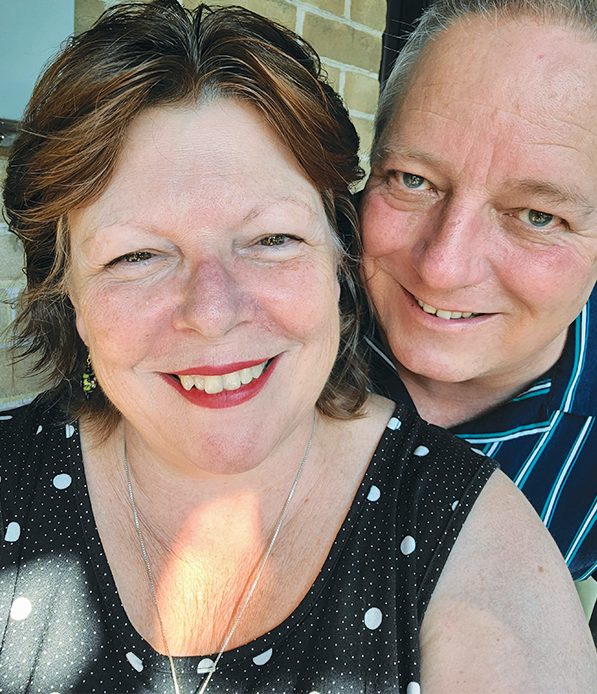
Fast forward: parents gone, farm sold, two marriages, two children, nursing career, city living, new career path and the ability to meet terrific people in various hospitals across the city. I’m closer to 60 than 50 these days. I have grandchildren, and yes, a third husband, who goes by the name Michael Mackin. (I got it right this time—third time is the charm!)
What do I look forward to now? You guessed it. A truck. A nice, new, shiny truck. It has to be red, metallic red. It needs a crew cab, of course, for the grandkids. Six cylinders, not eight—Dad would spin if he saw the price of gas now! And automatic transmission, sorry, but I’m not teaching my grandkids how to drive a manual stick. Oh no, I praise my dad and his perseverance in teaching me to drive, but I haven’t got his fearless genes!
“I want to buy a truck,” I voiced to Michael one day, who wisely agreed, saying it would be a good idea. So I got it—my very own truck. I’ve come full circle in my life. Maybe I should bring home a couple of chickens for the balcony… in my new truck!
Next, read the incredible story of how one man missed out on his dream car as a teenager, then found it parked in his driveway 25 years later!





